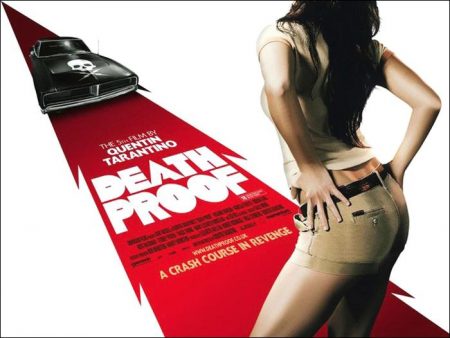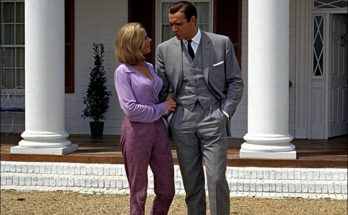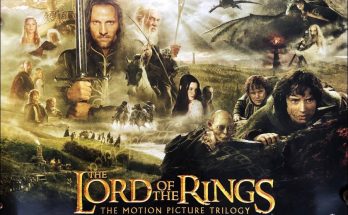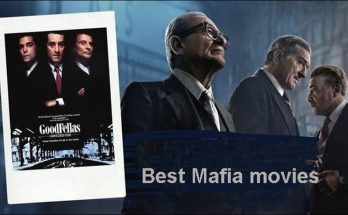Tarantino: Inspiration for Grindhouse and trailer. Two of the most renowned filmmakers go back to back with “Grindhouse”, a double dose packed to the gills with guns and guts. The unprecedented project from the longtime collaborators (“From Dusk Till Dawn”, “Four Rooms”, Sin City”) presents two original, complete films as a double feature. Quentin Tarantino’s “Death Proof” is a white knuckle ride behind the wheel of a psycho serial killer’s roving, revving, racing death machine. Robert Rodriguez’s “Planet Terror” is a heart-pounding trip to a town ravaged by a mysterious plague.
Inspired by the unique distribution of independent horror classics of the sixties and seventies, these two shockingly bold features are presented together on a drive-in style double bill, replete with fake trailers, missing reels and plenty of exploitative mayhem.
The impetus for “Grindhouse” began during a time before the multiplex and state-of-the-art home theaters ruled the movie-going experience. The origins of the term “Grindhouse” are fuzzy: some cite the types of films shown (as in “Bump-and-Grind”) in run down former movie palaces; others point to a method of presentation — movies were “grinded out” in ancient projectors one after another. Frequently, the movies were grouped by exploitation subgenre. Splatter, slasher, sexploitation, blaxploitation, cannibal and mondo movies would be grouped together and shown with graphic trailers. This was movie exhibition in its alternative heyday, simultaneously run-down and vividly alive.
“They were old houses that that were more dilapidated than existed for the people in the big city neighborhoods, or they were all-night theaters that would play three or four movies,” Tarantino explains. “It would be a place for the bums to go and sleep. If you’re hiding out from the law you’d go there for the night. Then, at six in the morning they wake you up and send you out, and you’d walk around for ninety minutes and come right back in again.” But exploitation movies weren’t just for urbanites: “Drive-ins had the same shows, but were a whole different setting,” Tarantino says. “Grindhouse theaters were in more urban areas. Dallas would have grindhouses, and Houston would have grindhouses, but when you get into the outer regions of Texas, it’s more about drive-ins.”
Theaters were booked independently. Film titles were changed from market to market and were promoted locally (especially in the case of the rural drive-ins). One print would travel from an old movie palace to a drive-in. “It wasn’t like the way movies are now, where a movie opens up on three thousand theaters playing everywhere at once,” Tarantino explains. “Exploitation companies would make maybe twenty prints for a big release. That was a huge release, actually. You would take those twenty prints to Houston, or Los Angeles. You’d just schlep them around the country, one place at a time. And they usually only played for a week. The grindhouses could get those movies that week they opened. They’d be backed by newspaper support, and be backed by television — local channel support.”
“Because they made so few prints that they would be scratched up and worn out, and have chunks chopped out of them by the time anybody saw them,” Rodriguez adds.
“If you were lucky enough to get an exploitation movie at the beginning of its run, the prints could be OK. But after it played at the El Paso Drive-In Theater, God knows what condition it might be in. It depends on what part of the daisy chain you lived in as far as how good the prints were going to be by the time you got them,” Tarantino says. “But grindhouses would also get the big budget films that had been playing back in the day when movies played for six months,” Tarantino notes. “They would also get them on their way out of town. ‘A Star Is Born’ came out in ’76, but you could easily see Barbra Streisand and Kris Kristofferson in “A Star Is Born” in the middle of ’77 playing with a kung fu movie.”
This unusual aberration from Hollywood production and distribution spawned some of the most shocking, exciting, and unusual movies of the ‘60s and ‘70s.
Though the filmmaking was often pedestrian, this era was extraordinarily democratic and enthusiasm and drive spawned unrelenting creativity. Many grindhouse films were bankrolled for only a few thousand dollars. They “worked” because of their ingenuity, or their absurdity, or their unique, effective storytelling. Budgetary constraints and an absence of studio-mandated rewrites allowed fertile imaginations to flourish.
“That shit was raw,” Tarantino exudes. “The shit was off the hook. Sexuality was wild. You couldn’t even believe some of the sexuality and brutality that they got away with in these movies, and gore. You literally had to pinch yourself and say, ‘Am I even watching what I’m watching?’”
Exploitation cinema offered sanctuary for those whose tastes lied on the periphery. They also gave a voice — albeit a sensationalistic, often stereotypical one — to society’s under-represented: people of color, gays and lesbians found increased representation in the form of films like “Vapors” (a one reel exploration of a gay bathhouse) and “Dolemete” (a blaxploitation classic). These films were marketed in a way that incited the most base of human impulses and preyed upon audiences most voyeuristic instincts.
Grindhouse advertisements enticed audiences with the promise of gore and violence. ‘Shock value’ took on an entirely new meaning with the onslaught of rape revenge, slasher and cannibal films. Ads for Wes Craven’s “The Last House On The Left” famously warned audiences: “To Avoid Fainting, Keep Repeating, ‘It’s Only A Movie. It’s Only A Movie. It’s Only A Movie.’”
In accordance with the marketing misinformation that permeated the grindhouses of the 60s and 70s, knockoffs (of both titles and plots) were commonplace. The success of “The Last House On The Left” begat “House On The Edge Of The Park” and “Last House On Dead End Street”. Neither film had anything to do with Craven’s original, though audiences were treated to similar homicidal depravities. Major releases also had their own grindhouse counterparts. “Jaws”, for instance, led a slew of animal-terrorizing-a-small-town films like “Tentacles”, “Pirhana”, and “Grizzly”.
“There was a big disconnect as far as what they were selling and what they actually had,” Tarantino says. “These little exploitation companies like had geniuses doing the fonts for the titles, and for the posters. They had great artists. Just give me that much talent from those guys and put it anywhere else, and they would explode. But oftentimes they weren’t selling the movie they had, they were selling the movie they wished they had. We are fans of these types of films and we’ve been let down before.”
But Tarantino and Rodriguez aren’t planning on letting anyone down. “This is a grindhouse movie made by people who love grindhouse movies. If you’re going to have a girl with a machine gun leg, it’s going to get used, and it’s going to get used well. That idea will be exhausted by the time the film’s finished,” Tarantino says. “The movie’s not a trick,” Rodriguez adds. “We’re not going to trick you in with the idea that it’s not going to be. It delivers.”
With this rich history as inspiration, Robert Rodriguez and Quentin Tarantino set out to make two very different, very complete movies and distribute them together as a double feature. The idea for this project began simply enough, when Rodriguez spotted a double bill poster at Tarantino’s house and commented that he had the same poster at his home. Rodriguez mentioned that he’d long wanted to make a double feature, and Tarantino suggested that they collaborate on the project together.
As the concept was developed further, the directors brought in some of their friends and collaborators to make “fake” trailers to be presented in front of and between their movies.
“When I would come over to Quentin’s house, he would show trailers, a feature, some more trailers, all vintage stuff,” Rodriguez says. “He would show different types of movies, different types of film prints — some of them really worn out, some of them really nice. That’s what we wanted to do. We thought, ‘Let’s make this experience that we have when we come over to Quentin’s house, for audiences all over the world. Fake trailers, two features, and make it a night at the movies.’”
Tarantino describes the invitation of Edgar Wright, director of “Shawn Of The Dead” and Eli Roth, director of “Cabin Fever” and “Hostel” to join him and Rodriguez on “Grindhouse”: “They just seemed natural guys to just step into the breech, especially where their interests were concerned. Eli would make a slasher film trailer using the one holiday that hadn’t been used: Thanksgiving.”
“And Edgar was going to do a 70s-style British horror film trailer because he remembered that nobody opens their mouth in the trailers. You never wanted the audience to know that it’s a British movie,” Tarantino jokes.
Rounding out the trio of trailer guest directors is Rob Zombie. Tarantino and Rodriguez were not the only classic exploitation and b-movie aficionados on set. Many of the actors appearing in “Grindhouse” had fond memories of the days of the double and triple feature. Freddy Rodriguez remembers: “When I was a kid in Chicago, my dad would take us to this big theater called The Tiffany, which used to play three karate movies for three bucks. We always joked that we would go in when the sun was up and come out when the sun was down and it was nighttime. We had a lot of fond memories going to grindhouse movies.”
“I grew up in the central coast of California, where we had great drive-ins,” Josh Brolin says. “You’d see a Bruce Lee movie, and then a Charles Bronson movie. The best part to me was that you got two bangs for your buck.”
Kurt Russell comments: “They’re trying to recreate a feeling, an evening. I refer to Quentin as the professor of ‘directology.’ I think that if Quentin could take the world into his cinema class he would say now this is the way movies were made, looked, and experienced in the late 60s and early 70s, if you went into the drive-in theater and saw two movies that night, this would be sort of the experience that you had, except with a modern-day storyline. They take it on it with an ode to those types of movies.”
Greg Nicotero, who created the special effects makeup in both “Planet Terror” and “Death Proof”, had distinct memories of visiting the projection booth of his local drive-in: “The projectionist would cut out the cool frames of all the neat monster gags. I went to see John Carpenter’s “The Thing” at the drive-in, and I was talking to the projectionist, and he said, ‘Oh, check this out.’ And he had cut out a frame of the spider head just because he thought it was a cool monster. And I thought, ‘If a movie gets sent all across the country, and every projectionist takes a couple of frames out, or the film breaks and they don’t really care how they put it back together, you watch a print that’s been destroyed.”
The irony of the wide distribution of this film in theaters is not lost on the filmmakers, but they have audiences’ safety in mind: “You’re going to go into a safe multiplex and watch this as opposed to a dangerous grindhouse, where you’d take your life in your hands,” Tarantino jokes. With “Grindhouse”, Rodriguez and Tarantino are at once nostalgic and progressive. With one foot in the past, the writer-directors create cinematic worlds that are wholly their own — save for some crossovers.
Rodriguez explains: “One of the things that excited us too is sometimes you’d see a double feature where Pam Grier was in both movies. She was a prisoner in one, and then she’s the warden in the other one. I thought; Wow, we could make that work.’”
“Planet Terror” finds noir-inspired romance amidst a future-shock vision of a chemical apocalypse. Informed by ZOMBIE and “Dawn Of The Dead”, as well as by the work of acclaimed director John Carpenter, Rodriguez creates a fresh and dynamic original take on the zombie genre. A simple night in a small town in Texas gives way to paranoia and espionage and hidden identities in a complex, layered narrative. “Planet Terror” builds upon the quick-paced, frenetic energy of Rodriguez’s explosive hit, Sin City.
Tarantino’s fifth film references some classic chase movies, from H.B. Halicki’s self-financed “Gone In 60 Seconds”, which contained a non-stop, forty minute car chase, to “Vanishing Point”, the nihilistic chase flick, to “Dirty Mary” “Crazy Larry”, a Peter Fonda vehicle. But Tarantino, no stranger to mixing genres, fuses the chase and slasher genres and comes up with something original. One can look to classic slasher fare like Bob Clark’s “Black Christmas”, Herschell Gordon Lewis’s “Blood Feast”, and “House At The Edge Of The Park” for the advent of the predatory psycho.
“Death Proof” is also Tarantino’s most linear film: events are presented chronologically and breaks in time are punctuated with title cards. Though the action is sequential, the contents of this unfamiliar structure are no less intriguing than that of any of his previous films. Jungle Julia and Zoë Bell (and the rest of his eight girl posse) turn the concept of the “final girl,” a staple of the slasher genre, on its ear. He gives characters a lifeline that would make Hitchcock’s Marion Crane seem like a cinematic stranger, and then builds a distinct narrative of revenge-by-proxy.
As much as “Death Proof” has a ‘70s sensibility, in fashion, transportation and in filmic tradition, the conditions of the characters are ultra-modern and personal. Tarantino delights in the details of these women’s everyday lives: expressions of romance abbreviated and delivered via text message, descriptions of hookups and dating rules, and exasperation with self-reflexive careers. All the while, an insurmountable tension builds with each sideways glance from the loner with the pompadour sitting at the bar…
Visits: 100



